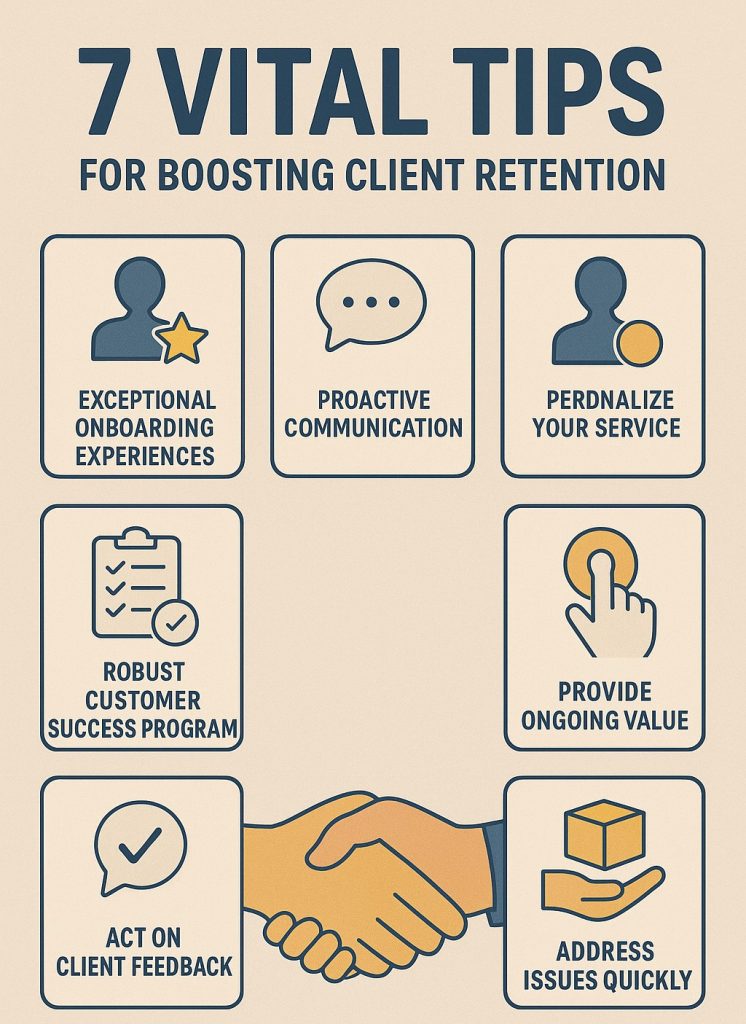Client retention stands as one of the most critical metrics for sustainable business growth. While acquiring new customers often receives significant attention, retaining existing clients proves far more cost-effective and profitable in the long run, and studies consistently show that if you boost customer retention rates by just 5%, you can increase profits by 25% to 95%.
Here are seven essential strategies, listed and explained after the infographic, to keep your clients engaged and loyal.

1. Deliver Exceptional Onboarding Experiences
The first impression sets the tone for the entire client relationship. A well-structured onboarding process ensures clients understand your product or service from day one, reducing confusion and frustration that often leads to early churn.
Create a comprehensive welcome package that includes clear instructions, helpful resources, and designated contact points. Set realistic expectations about timelines and deliverables while providing regular check-ins during the initial weeks – this proactive approach demonstrates your commitment to client success from the very beginning.
2. Maintain Consistent and Proactive Communication
Regular communication keeps clients informed and engaged while preventing small issues from becoming major problems. Try to establish a structured communication schedule that includes progress updates, industry insights, and relevant news that could impact their business, and don’t wait for clients to reach out with concerns or questions. Instead, anticipate their needs and provide valuable information before they ask for it, as this approach positions you as a trusted advisor rather than just a service provider.
3. Implement a Robust Customer Success Program
Understanding the benefits of employing a customer success manager becomes clear when you see how this role transforms client relationships.
Customer success managers serve as dedicated advocates who monitor client health, identify growth opportunities, and ensure clients achieve their desired outcomes. They proactively address potential issues, facilitate smooth implementations, and guide clients toward maximizing value from your offerings, and this specialized focus on client success significantly improves retention rates and expands account value over time.
4. Personalize Your Service Approach
Every client has unique needs, challenges, and goals, and generic one-size-fits-all approaches often fail to create the personal connection necessary for long-term retention. When you invest time in understanding each client’s specific industry, company culture, and individual preferences, you can customize your communications, solutions, and service delivery to align with their particular requirements.
This personalized attention makes clients feel valued and understood, strengthening their emotional connection to your brand.
5. Actively Seek and Act on Client Feedback
Collecting feedback provides invaluable insights into client satisfaction and areas for improvement. Implement multiple feedback channels, including surveys, phone calls, and face-to-face meetings, to gather comprehensive input about your performance. It also demonstrates that you’re listening by implementing suggested improvements and communicating these changes back to clients. When clients see their input driving positive changes, they feel more invested in the relationship and more likely to remain loyal.
6. Provide Ongoing Value and Education
Client relationships should continuously evolve to provide increasing value over time.
- Offer regular training sessions, workshops, or webinars that help clients maximize their investment in your products or services.
- Share industry best practices, relevant case studies, and insights that can improve their business operations.
- Create a client portal with exclusive resources, tools, and educational content.
This ongoing value delivery reinforces why clients chose you initially and gives them compelling reasons to continue the relationship.
7. Address Issues Quickly and Transparently
Problems will inevitably arise in any business relationship, but how you handle them determines whether clients stay or leave. Be sure to establish clear escalation procedures and response time commitments for different types of issues.
When problems do occur, communicate transparently about what happened, what you’re doing to fix it, and how you’ll prevent similar issues in the future. Clients who experience well-handled problem resolution become even more loyal than those who never encounter any issues.
Client retention requires ongoing effort and strategic thinking, but the investment pays significant dividends. If you can implement these seven strategies consistently, you’ll build stronger relationships, reduce churn, and create a foundation for sustainable growth.
Remember that retained clients not only provide recurring revenue but also serve as valuable referral sources, amplifying your business development efforts naturally.





